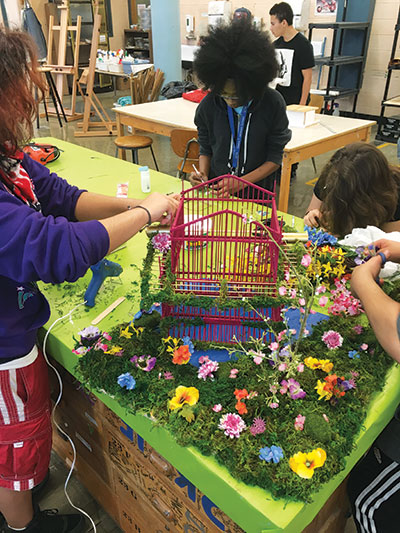 Jacobo Lovo, gallery manager from the Latino Arts Center in Sheboygan, Wisconsin, organized a student group art exhibition focusing on a dialogue around journey and immigration stories. Participating schools included Sheboygan North High School, University School of Milwaukee, Bruce Guadalupe Community School, St. Robert School, Milwaukee High School of the Arts, UCC Acosta Middle School, Milwaukee Jewish Day School, Central City Cyber School, and Repairing Together.
Jacobo Lovo, gallery manager from the Latino Arts Center in Sheboygan, Wisconsin, organized a student group art exhibition focusing on a dialogue around journey and immigration stories. Participating schools included Sheboygan North High School, University School of Milwaukee, Bruce Guadalupe Community School, St. Robert School, Milwaukee High School of the Arts, UCC Acosta Middle School, Milwaukee Jewish Day School, Central City Cyber School, and Repairing Together.
Our daily lives are filled with confusion, frustration, and uncertainty stemming from what we see and hear from the political, social, and cultural landscapes that are affecting our society and our youth. This exhibition united art teachers and students in reflecting on our past, present, and optimism for the future.
Here We Make Our Home encouraged and challenged young adults to learn about who they are, research their cultural heritage, and share their views and beliefs in what it means to be of African American, Hispanic, Asian, or European descent living in the United States of America. Birdhouses as Vehicles for Storytelling Using the birdhouse as an entry point, the exhibit gave teachers and students an opportunity to create a unique piece of art that told the story of their personal journey. Some students approached this through family heritage; others by recounting seminal personal experiences.
Birdhouses as Vehicles for Storytelling
Using the birdhouse as an entry point, the exhibit gave teachers and students an opportunity to create a unique piece of art that told the story of their personal journey. Some students approached this through family heritage; others by recounting seminal personal experiences. Birdhouses were selected as the vehicle for storytelling to represent the idea of home, settlement, and migration. The artwork could take on any form, and a variety of materials were used to produce two- and three-dimensional art.
Student Experiences Students who participated in the project went outside their usual comfort zones in regards to choice of media, and demonstrated a willingness to take risks and to work in groups with students they didn’t have a previous relationship with. Their unique experiences gave them the motivation to engage in creative problem solving in order to express their personal trials and challenges.
Lee, a student from the Milwaukee High School of the Arts, stated, “I gained a better understanding of my peers, and I learned the history of their ancestors. I was able to see similarities of how each culture was oppressed. This project gave me insight, and I was able to take many things away from it and enjoyed conveying our message in an artistic way.”
Teacher Experiences
Jessica Michels, art teacher at the University School of Milwaukee, said, “Mr. Lovo came to our school to talk to our students. They were moved by his personal journey as a child to America. Each of our students interpreted their personal journey in their own way. Some of them chose to tell a story of how their families had made their homes in different parts of the world, while other students conveyed personal struggles or evidence of hard work and dedication.”
Carrie Hoelzer found this to be an opportunity to view her students through a unique lens she would have otherwise not been afforded. Students wrote about their experiences with the deaths of family members, parents leaving the family, grandparents with terminal diseases, coming to grips with their sexual identities, and many other personal topics. Because of this insight into students’ experiences, she was able to see them in a different light and move forward with an increased sense of empathy, bringing Carrie and her students closer as a community,
Frank Juarez had his art students collaborate with poetry students. Students each created their own artworks based on their upbringing and swapped them to do a response piece in written or visual form. This forged a bond between these students and they gained a better understanding of how similar they are.
A Global Community
Group collaborations that address very authentic topics such as this serve to bring together participants and their communities. Students from schools with vastly different demographics were able to discover similarities, as well as unique challenges, that others face on a daily basis. These experiences help to create the global community of world citizens that our country especially needs in the evolving world.
Frank Juarez is the art department head at Sheboygan North High School in Sheboygan, Wisconsin, and co-editor of this issue. fjuarez@sasd.net
Carrie Hoelzer is an art teacher at the Milwaukee High School of the Arts in Milwaukee, Wisconsin.
NATIONAL STANDARD
Connecting: Relate artistic ideas and work with societal, cultural, and historical content to deepen understanding.
WEB LINKS
www.latinoartsinc.org
View this article in the digital edition.


 Jacobo Lovo, gallery manager from the Latino Arts Center in Sheboygan, Wisconsin, organized a student group art exhibition focusing on a dialogue around journey and immigration stories. Participating schools included Sheboygan North High School, University School of Milwaukee, Bruce Guadalupe Community School, St. Robert School, Milwaukee High School of the Arts, UCC Acosta Middle School, Milwaukee Jewish Day School, Central City Cyber School, and Repairing Together.
Jacobo Lovo, gallery manager from the Latino Arts Center in Sheboygan, Wisconsin, organized a student group art exhibition focusing on a dialogue around journey and immigration stories. Participating schools included Sheboygan North High School, University School of Milwaukee, Bruce Guadalupe Community School, St. Robert School, Milwaukee High School of the Arts, UCC Acosta Middle School, Milwaukee Jewish Day School, Central City Cyber School, and Repairing Together.